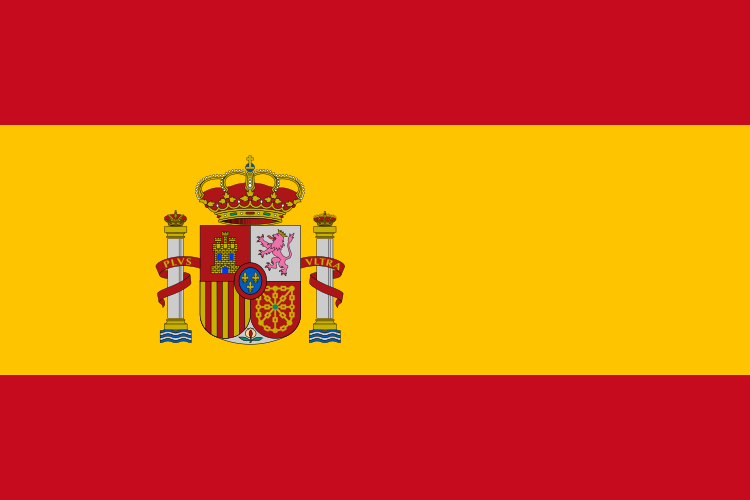The Spain flag features three primary colors: Red, Yellow. The table below showcases the common and popular codes for these colors in HEX, RGB, and CMYK formats, along with Pantone (PMS), RAL, and NCS (Natural Color System) references. Remember, HEX and RGB codes are ideal for digital projects and web design (including HTML and CSS), while CMYK values are tailored for printing purposes.
The flag of Spain, known as the "Rojigualda", is a vibrant and historically rich symbol representing the nation's unity, sovereignty, and cultural heritage. Here is a detailed description of its design, symbolism, historical context, and overall significance:
Design and Elements
Colors and Layout:
- The flag consists of three horizontal stripes: a red stripe at the top, a yellow stripe in the middle, and a red stripe at the bottom.
- The yellow stripe is twice the height of each red stripe, creating a proportion of 1:2:1.
National Coat of Arms:
- The flag features the national coat of arms offset towards the hoist (left) side, positioned in the center of the yellow stripe.
- The coat of arms is composed of several elements:
- Pillars of Hercules: Two vertical pillars with the inscription "PLUS ULTRA," meaning "More Beyond," topped with crowns.
- Shield: Divided into four quadrants representing historic kingdoms:
- The first quadrant (top left) represents the Kingdom of Castile with a castle.
- The second quadrant (top right) represents the Kingdom of León with a lion.
- The third quadrant (bottom left) represents the Crown of Aragon with vertical red and yellow stripes.
- The fourth quadrant (bottom right) represents the Kingdom of Navarre with linked chains.
- Enté en point: A pomegranate flower at the bottom represents the Kingdom of Granada.
- Bourbon-Anjou Shield: An inescutcheon (small shield) in the center represents the reigning House of Bourbon-Anjou.
- Crown: The shield is topped with the Spanish royal crown.
Proportions:
- The flag’s width-to-length ratio is typically 2:3.
Symbolism
Colors:
- Red and Yellow: These colors are believed to have been chosen for their historical connection to the traditional colors of the Kingdom of Aragon and the historical significance in Spanish heraldry. Red and yellow are also visually striking and symbolize strength and valor.
Coat of Arms:
- Pillars of Hercules: Symbolize Spain's historical role in exploration and expansion, with the motto "PLUS ULTRA" indicating the country's global influence.
- Quadrants of the Shield: Represent the unity of the historic kingdoms that formed modern Spain.
- Pomegranate Flower: Represents the integration of Granada into Spain.
- Royal Crown: Denotes the constitutional monarchy of Spain.
Historical Context
Adoption:
- The current design of the flag was officially adopted on December 19, 1981, though its origins trace back to the naval ensign of 1785 during the reign of King Charles III.
Evolution:
- The flag has undergone various modifications, especially to the coat of arms, reflecting changes in the monarchy and state structure.
Historical Significance:
- The flag has been a symbol of national unity and sovereignty through different political regimes, including the Spanish Republic, Francoist Spain, and the current democratic monarchy.
Overall Significance
The flag of Spain is a powerful emblem of national identity, unity, and the country's rich historical and cultural heritage. It represents Spain's territorial integrity, its monarchy, and its influential role in world history. The flag is prominently displayed during national holidays, official ceremonies, and international events, symbolizing Spain’s sovereignty and its place in the global community.
Cultural and National Identity
The flag serves as a unifying symbol for the people of Spain, reflecting their shared heritage, pride in their nation’s achievements, and commitment to building a peaceful and prosperous future. It is a source of national pride and a reminder of the country's enduring legacy and its commitment to unity and development.
Unique Feature
- Incorporation of Historical Elements:
- The detailed coat of arms on the flag incorporates significant historical elements, representing the unification of various kingdoms and Spain’s historical legacy.
In summary, the flag of Spain is not only a representation of the nation’s historical and cultural heritage but also a symbol of its unity and aspirations for the future. It embodies the spirit, resilience, and unity of the Spanish people, celebrating their past while looking forward to continued growth and prosperity.
